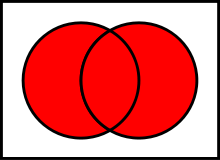Union (set theory)




In set theory, the union (denoted as ∪) of a collection of sets is the set of all distinct elements in the collection.[1] The union of a collection of sets  gives a set
gives a set  .
.
Contents |
Definition
The union of two sets A and B is the collection of points which are in A or in B (or in both):

A simple example:
Other more complex operations can be done including the union, if the set is for example defined by a property rather than a finite or assumed infinite enumeration of elements. As an example, a set could be defined by a property or algebraic equation, which is referred to as a solution set when resolved. An example of a property used in a union would be the following:
- A = {x is an even number, x > 1}
- B = {x is an odd number, x > 1}

If we are then to refer to a single element by the variable "x", then we can say that x is a member of the union if it is an element present in set A or in set B, or both.
Sets cannot have duplicate elements, so the union of the sets {1, 2, 3} and {2, 3, 4} is {1, 2, 3, 4}. Multiple occurrences of identical elements have no effect on the cardinality of a set or its contents. The number 9 is not contained in the union of the set of prime numbers {2, 3, 5, 7, 11, …} and the set of even numbers {2, 4, 6, 8, 10, …}, because 9 is neither prime nor even.
Algebraic properties
Binary union is an associative operation; that is,
- A ∪ (B ∪ C) = (A ∪ B) ∪ C.
The operations can be performed in any order, and the parentheses may be omitted without ambiguity (i.e. either of the above can be expressed equivalently as A ∪ B ∪ C). Similarly, union is commutative, so the sets can be written in any order. The empty set is an identity element for the operation of union. That is, A ∪ {} = A, for any set A. In terms of the definitions, these facts follow from analogous facts about logical disjunction.
Together with intersection and complement, union makes any power set into a Boolean algebra. For example, union and intersection distribute over each other, and all three operations are combined in De Morgan's laws. Replacing union with symmetric difference gives a Boolean ring instead of a Boolean algebra
Forms
Finite unions
More generally, one can take the union of several sets at once. The union of A, B, and C, for example, contains all elements of A, all elements of B, and all elements of C, and nothing else. Formally, x is an element of A ∪ B ∪ C if and only if x is in A, B, or C.
Union is an associative operation, it doesn't matter in what order unions are taken. In mathematics a finite union means any union carried out on a finite number of sets: it doesn't imply that the union set is a finite set.
Infinite unions
The most general notion is the union of an arbitrary collection of sets. If M is a set whose elements are themselves sets, then x is an element of the union of M if and only if for at least one element A of M, x is an element of A. In symbols:
That this union of M is a set no matter how large a set M itself might be, is the content of the axiom of union in axiomatic set theory.
This idea subsumes the above paragraphs, in that for example, A ∪ B ∪ C is the union of the collection {A,B,C}. Also, if M is the empty collection, then the union of M is the empty set. The analogy between finite unions and logical disjunction extends to one between arbitrary unions and existential quantification.
The notation for the general concept can vary considerably, such as the following:
which refers to the union of the collection {Ai : i is in I}. Here I is an index set, and Ai is a set for every i in I. In the case that the index set I is the set of natural numbers, the notation is analogous to that of infinite series:
When formatting is difficult, this can also be written "A1 ∪ A2 ∪ A3 ∪ ···". (This last example, a union of countably many sets, is very common in analysis; for an example see the article on σ-algebras.) Whenever the symbol "∪" is placed before other symbols instead of between them, it is of a larger size.
Intersection distributes over infinitary union, in the sense that
Infinitary union can be combined with infinitary intersection to get the law
 .
.
See also
- Naive set theory
- Symmetric difference
- Disjoint union
- Intersection (set theory)
- Complement (set theory)
- Cardinality
- Iterated binary operation
Notes
- ↑ Weisstein, Eric W. "Union". Wolfram's Mathworld. http://mathworld.wolfram.com/Union.html. Retrieved 2009-07-14.
External links
- Infinite Union and Intersection at ProvenMath De Morgan's laws formally proven from the axioms of set theory.








